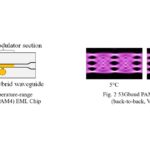ASIA ELECTRONICS INDUSTRYYOUR WINDOW TO SMART MANUFACTURING
Mitsubishi Electric to Ship New Ultrafast Receiver IC
Mitsubishi Electric Corporation will begin shipping samples of the 200Gbps PIN-photodiode (PD) chip for use in next-generation optical transceivers from October 1 this year. Primarily, the new PIN-PD chip, model PD7CP47, will support 800Gbps and 1.6Tbps fiber communication.

Specifically, the addition of the new receiver chip to Mitsubishi Electric’s optical device lineup will enable existing devices capable of transmitting at 800Gbps/1.6Tbps to newly receive optical data at these same speeds. Thus, it expands the communication capacity of optical transceivers, including for high-speed, high-capacity communication in data centers.
The upcoming introduction of the 200Gbps PIN-PD chip for optical reception follows the launch of Mitsubishi Electric’s mass-produced chip for optical transmission, the 200Gbps (112Gbaud four-level pulse-amplitude modulation [PAM4]) electro-absorption modulator laser diode (EML), in April this year.
Also, the new PD chip was developed by minimizing the photoelectric conversion area within a chip structure that integrates backside illumination* and a convex lens. To this end, it leveraged the company’s well-established expertise in optical devices.
* A structure in which the pin junction is on the front side of the semiconductor substrate. This allows incidental light to be received on the opposite (back) side.
Product Features
1) Backside illumination and convex lens integrated for high-speed, high-capacity communication in data centers
– The chip structure integrates backside illumination and a light-accumulating convex lens that minimizes the photoelectric conversion area. This results in low capacitance to enable high-speed 200Gbps transmission (112Gbaud PAM4), twice that of conventional mainstream products (100Gbps).
– An optical transceiver equipped with four of these new PD chips achieves 800Gbps communication and eight chips enable 1.6Tbps communication, which will contribute to high-speed, high-capacity data centers.

2) Enables optical transceivers to be assembled more efficiently and manufactured at lower cost
– The convex lens increases the light-receiving area by about four times compared to conventional structures. This allows the new PD chip to receive slightly off-center incident light. Basically, eliminating the need for precise alignment of the incident light contributes to more efficient assembly of optical transceivers.
– The electrodes can be flip-chip mounted** on signal-amplification ICs and substrates. Thus, it eliminates the wire connection process during assembly and reducing manufacturing costs.
** A method of mounting a chip upside down on another component.

Main Specifications
Generally, the demand for high-speed, high-capacity networks is growing rapidly. This is due to dramatically increasing data communication volume. In turn, this results from the proliferation of network-connected terminals, the expansion of high-resolution video streaming, and the popularization of generative AI technology. Especially in data centers, where the market is growing rapidly, communication speeds are shifting from 400 to 800Gbps and even 1.6Tbps. While there are products capable of 800Gbps/1.6Tbps optical transmission, few products are also capable of reception at these speeds.
Environmental Awareness
This product is compliant with RoHS directive 2011/65/EU and (EU) 2015/863.
-20 August 2024-




